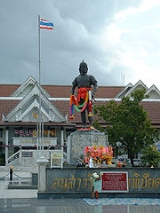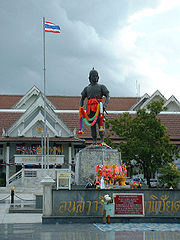
Phraya Phichai
Encyclopedia

Thai language
Thai , also known as Central Thai and Siamese, is the national and official language of Thailand and the native language of the Thai people, Thailand's dominant ethnic group. Thai is a member of the Tai group of the Tai–Kadai language family. Historical linguists have been unable to definitively...
พระยาพิชัยดาบหัก; Phraya Phichai of the broken sword) (born: 1741 at Ban Huai Kha, Amphoe
Amphoe
An amphoe is the second level administrative subdivision of Thailand. Usually translated as district, amphoe make up the provinces, and are analogous to a county seat...
Phichai, Changwat Uttaradit
Uttaradit Province
Uttaradit is one of the northern provinces of Thailand. Neighboring provinces are Phitsanulok, Sukhothai, Phrae and Nan...
; died: 1782) was a historic Thai nobleman in the Ayutthaya period who fought with a sword in each hand until one was broken.
History
Phraya Phichai was a Siamese general serving under King TaksinTaksin
Taksin ; was the only King of the Thonburi Kingdom...
. After the fall of Ayudhya
Ayutthaya kingdom
Ayutthaya was a Siamese kingdom that existed from 1350 to 1767. Ayutthaya was friendly towards foreign traders, including the Chinese, Vietnamese , Indians, Japanese and Persians, and later the Portuguese, Spanish, Dutch and French, permitting them to set up villages outside the walls of the...
in 1767, Phraya Pichai and Chao Phraya Chakri (who later become the first King of Chakri Dynasty) followed Phraya Taksin in repelling the Burmese and reuniting Siam. They were considered Phraya Taksin's left and right hands.
In 1782, King Taksin
Taksin
Taksin ; was the only King of the Thonburi Kingdom...
showed signs of mental illness
Mental illness
A mental disorder or mental illness is a psychological or behavioral pattern generally associated with subjective distress or disability that occurs in an individual, and which is not a part of normal development or culture. Such a disorder may consist of a combination of affective, behavioural,...
. At that time, the nation still lacked stability and was in need of a strong ruler. A coup executed King Taksin, then the throne was offered to Chao Phraya Chakri. Phraya Pichai, a devout follower of King Taksin, was not spared, and by most account, requested for his own execution to follow King Taksin to his death. He was executed soon after.
He gained the name 'Phraya Phichai Dabhak' or 'Phraya Pichai Broken Sword' in a battle in which he kept fighting (and won) even after one of his blades was broken in half.
Birth
Phraya Phichai was born in 1741 at Ban Huai Kha, AmphoeAmphoe
An amphoe is the second level administrative subdivision of Thailand. Usually translated as district, amphoe make up the provinces, and are analogous to a county seat...
Phichai, Changwat Uttaradit
Uttaradit Province
Uttaradit is one of the northern provinces of Thailand. Neighboring provinces are Phitsanulok, Sukhothai, Phrae and Nan...
, having four brothers and sisters but three of them died before Phichai”s birth. His parents were unknown. His birthname was Choi (th:
Thai language
Thai , also known as Central Thai and Siamese, is the national and official language of Thailand and the native language of the Thai people, Thailand's dominant ethnic group. Thai is a member of the Tai group of the Tai–Kadai language family. Historical linguists have been unable to definitively...
จ้อย; means: the little one).
Childhood
When Choi was a young boy, he loved to practice Thai boxing and would always be running away without his parents knowing, to train in the art. He trained with many teachers of that time.One day, Choi left home northernwards and met with a boxing instructor named “Thiang” (th:
Thai language
Thai , also known as Central Thai and Siamese, is the national and official language of Thailand and the native language of the Thai people, Thailand's dominant ethnic group. Thai is a member of the Tai group of the Tai–Kadai language family. Historical linguists have been unable to definitively...
เที่ยง) at Wat
Wat
A wat is a monastery temple in Cambodia, Thailand, or Laos. The word "wat" means "school".- Introduction :...
Ban Kaeng (th:
Thai language
Thai , also known as Central Thai and Siamese, is the national and official language of Thailand and the native language of the Thai people, Thailand's dominant ethnic group. Thai is a member of the Tai group of the Tai–Kadai language family. Historical linguists have been unable to definitively...
วัดบ้านแก่ง). Choi then became a beloved student of Instructor Thiang and renamed as “Thong Di” (th:
Thai language
Thai , also known as Central Thai and Siamese, is the national and official language of Thailand and the native language of the Thai people, Thailand's dominant ethnic group. Thai is a member of the Tai group of the Tai–Kadai language family. Historical linguists have been unable to definitively...
ทองดี), his instructor called him as “Mister Thong Di Fan Khao” (th:
Thai language
Thai , also known as Central Thai and Siamese, is the national and official language of Thailand and the native language of the Thai people, Thailand's dominant ethnic group. Thai is a member of the Tai group of the Tai–Kadai language family. Historical linguists have been unable to definitively...
ทองดีฟันขาว; means: Thong Di whose teeth are white) as he did not chew betel nut
Betel nut
The Areca nut is the seed of the Areca palm , which grows in much of the tropical Pacific, Asia, and parts of east Africa. It is commonly referred to as "betel nut" as it is often chewed wrapped in betel leaves.-Description:...
. The Thai people loved chewing betel nut, which made their teeth black, since the ancient time until the Government under the premiership of Field Marshal Plaek Phibunsongkhram
Plaek Pibulsonggram
Field Marshal Plaek Pibunsongkhram , often known as Phibun Songkhram or simply Phibun in English, was Prime Minister and virtual military dictator of Thailand from 1938 to 1944 and 1948 to 1957.- Early years :...
issued ban on chewing the nut in 1942.
Serving the Crown
One day, Phraya TakTaksin
Taksin ; was the only King of the Thonburi Kingdom...
was holding a boxing contest in the city of Tak during a traditional festival. Now a young man of twenty years, Thong Di asked the ring master to find him a match. The towns people having never seen the boxer before suggested that he take an opponent who had little experience so that it would make an exciting fight, but Thong Di insisted that he would fight the most skillful boxer in the town.
A famous boxing master of Tak, Arjarn Nai Hao, who nobody dared to challenge, gladly agreed to take the fight, knowing that those who had challenged the master before had been soundly and thoroughly beaten, why should this young upstart be any different? A huge crowd gathered to see the young boxer Thong Di fight the invincible Nai Hao.Throughout the bout Thong Di showed brilliant Thai boxing style.
Seeing a resounding victory over Nai Hao after witnessing such a formidable display, Phraya Tak showed no hesitation in asking Thong Di to join his army. On many occasions, Thong Di would display his talents in the Thai boxing ring before Phraya Tak (later to become King Taksin the great of Thonburi). His skill and bravery in the ring and the fact that no other boxer could defeat Thong Di, were very pleasing to Phraya Tak who appointed him to be his personal bodyguard.
The Emperor of China Kao Tsung, was alarmed by the military might of the Burmese. From 1766- 1769, the Emperor sent his armies four times to subdue the Burmese, but all four invasions failed. Siam was under the control of the Burmese since the sacking of Ayutthaya, but had to withdraw the bulk of its army from Siam to ward of the Chinese invasions, leaving behind only a small contingent. Phraya Tak taking advantage of the situation, organized his force and revolted.
Phraya Tak; At first was a guerrilla leader with only five hundred followers but within fifteen years his dominion was to embrace all of Siam. During the revolt Taksin managed to escape to Rayong on the East coast of Siam. Here with the help of Phraya Phichai, now his Commander-in-Chief, raised an army and declared all out war on Burma. The action was to eventually regain freedom for the Siamese people.
Phraya Phichai or (Thong Di), under the guidance of Phraya Tak and using guerrilla tactics, won back many small towns and villages from the Burmese. It was during one of the many battles, that Thong Di was to become famous. In 1773 an army under celebrated Burmese General Bo Supia
Ne Myo Thihapate
Ne Myo Thihapate was a general in the Royal Burmese Army of Konbaung Dynasty of Burma . The general is best known for conquering the Ayutthaya Kingdom, along with Gen. Maha Nawrahta, in April 1767.-Career:...
was sent to capture the City of Phichai. Thong Di led the Thai army and fought him at Wat Aka and Phraya Sura Sri
Maha Sura Singhanat
Somdet Phra Bawornrajchao Maha Sura Singhanat was the younger brother of Buddha Yodfa Chulaloke, the first monarch of the Chakri dynasty of Siam. As an Ayutthayan general, he fought alongside his brother in various campaigns against Burmese invaders and the local warlords...
helped him battle the Burmese. The Burmese general was driven into retreat while sustaining great losses to his troops.
The One with Broken Sword
In the heat of the battle which Thong Di fought with Sang ma dap (two handed swords) and after many fierce engagements he slipped and used one of his swords to control himself by pointing it into the ground, as he leaned on the sword it broke in half. Thong Di used his Thai boxing techniques. One dap and one broken one, he led his army to victory forcing the Burmese back across the border.As a result of this battle he was known as “Phraya Phichai Dap Hak”. Eventually after fifteen years of war the Siamese under “King Taksin the Great" had forced the Burmese army back and Siam regained all of its original frontiers.
When King Taksin died, the new King Rama I of the Chao Phraya Chakri Dynasty (the present day rulers), he declared his new capitol Bangkok. As a reward for his loyalty and service to his country King Rama asked Phraya Phichai if he would continue his good work as the king’s guard. (In these times the law of the land stated that once a King died, his bodyguards and loyal servants should die with him), but King Rama offered to take an exception for Phraya Phichai.
However, Phraya Phichai was so saddened by the death of his beloved King Taksin that he ordered the executioner to do away with him, despite King Rama's kindness. Such was the loyalty that Phraya Phichai had for King Taksin. Instead he asked King Rama to raise his son and in time that son could become King”s personal bodyguard in his fathers place.
Phraya Phichai was executed on his own order when he was 41 years old. A monument built to the memory of Phraya Phichai in 1969. The bronze image of the great warrior stand proudly in front of the Parliament Building in Uttarradit and serves to remind each generation of the amazing man”s courage and loyalty to his King and the Thai nation. The epitaph reads "In memory and loving honor for the pride of our nation".

